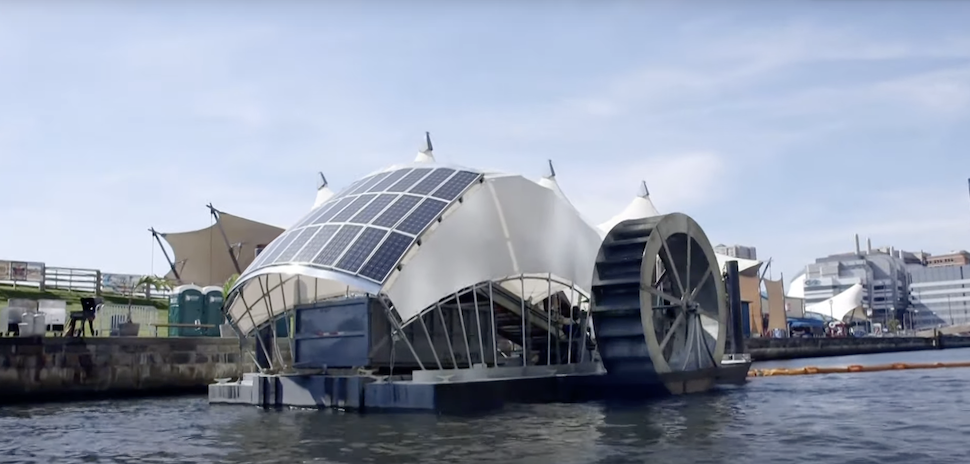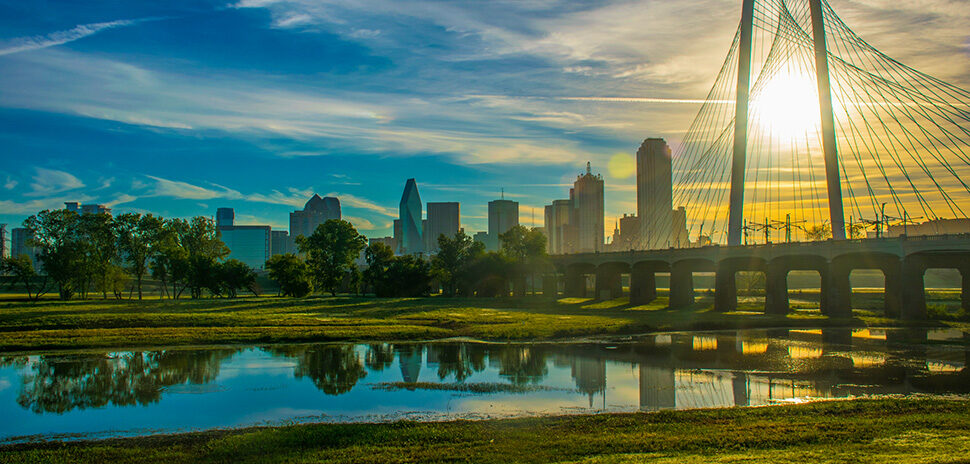It’s the most preposterous-looking thing to hit water since my Uncle Ernie belly-flopped in Lake Tawakoni. But that strange contraption above can gobble up to 25 tons of trash daily from a river’s surface—and ones just like it are headed to Fort Worth.
Charmingly retro-futuristic, it looks like something Kevin Costner would have steered in his epic sci-fi flop “Waterworld.” The one seen above was created by a Maryland company called Clearwater Mills to keep Baltimore’s Inner Harbor pristine. It removes 20 tons of trash per month from the mouth of the city’s Jones Falls, stopping it from entering the harbor.
A cross between a UFO, a covered wagon, and an old water mill, it’s sustainably self-powered by the sun and river currents. The current turns the waterwheel; solar-powered pumps work a conveyer to lift trash and deposit it into a detachable dumpster.
The “Waterwheel-Powered Trash Interceptor” has a canopy cover laden with solar panels capable of producing 30 kilowatt-hours of electricity each day. That’s enough to power a typical home for one day—or scarf up tons of bottles, candy wrappers, tires, lumber, and whatever else might be floating along.
Fort Worth and Tarrant Regional Water District are buying two
The City of Fort Worth, the Tarrant Regional Water District, and community partners plan to buy two of the waterwheels. On Tuesday, the Fort Worth City Council voted to accept private donations to support the initiative. Each waterwheel will cost about $600,000 and require only an estimated $50,000 a year in maintenance costs.
The yearly $50K will cover the disposal of collected wastes, system checks, and annual system audits to maintain the waterwheels.
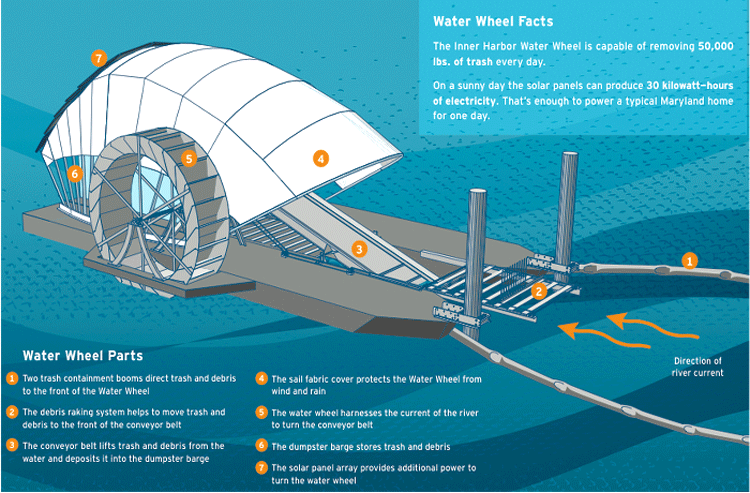
Baltimore’s Inner Harbor Water Wheel. [Graphic courtesy of Health Harbor]
‘Results are astonishing’
“Everyone wants access to clean water and the ability to enjoy recreational activities without coming into contact with trash or stormwater pollution,” said Brandon Bennett, Fort Worth’s code compliance director, in a statement. “The concept behind waterwheels couldn’t be any simpler, but the results are astonishing when it comes to cleaning tons of trash pollution from waterways in a short period of time.”
One for the Clear Fork, one for the West Fork
Two sites for the waterwheels have been identified near downtown Fort Worth. The one shown below is near the Henderson Street Bridge on the river’s West Fork.
As you can see, booms will guide floating trash into the waterwheel’s trash interceptor. Small boats will be able to navigate around the booms.The entire waterwheel structure is about 52 feet long by 24 feet wide. The waterwheel itself is 14 tall and 3 feet wide:
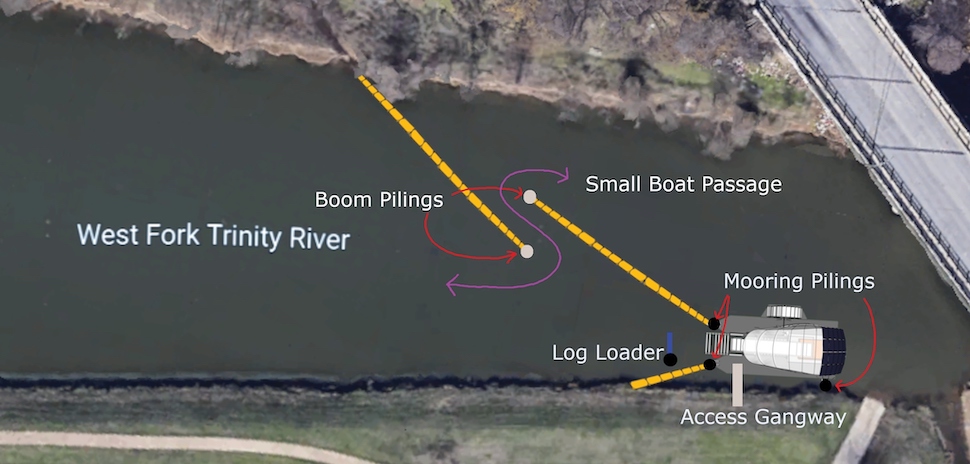
Henderson Street Bridge site of a Fort Worth waterwheel placement. [Image: fortworthtexas.gov]
The other proposed site is at the Purcey Street Outfall of the river’s Clear Fork, as seen below. The trash transfer ramp is visible on the north side of the river. A dumpster guide cable will allow the detachable dumpster to be retrieved for trash disposal. Small boats can pass through the booms here, too:
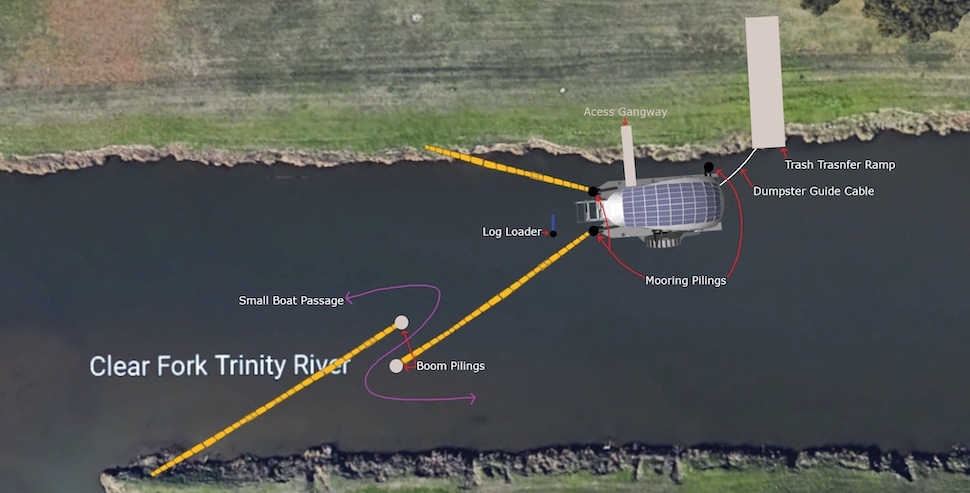
Purcey Street Outfall site of a Fort Worth waterwheel placement. [Image: fortworthtexas.gov]
‘A gigantic solution to cleaner waterways’
The waterwheels are “a gigantic solution to cleaner waterways,” the city says on a microsite for the project. Benefits include cleaner drinking water for Fort Worth and surrounding cities; improved habitats for fish and wildlife; and a far more inviting river to paddle on or hike along.
Fort Worth is home to over 100 miles of trails along the Trinity River and its tributaries, so the waterwheels will help give hikers, joggers, and bikers picture-perfect views.
Now seeking donations for the Waterwheels
The city is now seeking private donations to help support the Trinity River Waterwheels project. You can find out how to donate by going here.
![]()
Get on the list.
Dallas Innovates, every day.
Sign up to keep your eye on what’s new and next in Dallas-Fort Worth, every day.

